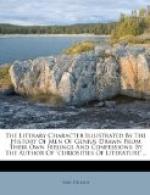Artists and literary men, alike insulated in their studies, pass through the same permanent discipline; and thus it has happened that the same habits and feelings, and the same fortunes, have accompanied men who have sometimes unhappily imagined their pursuits not to be analogous.
Let the artist share
The palm; he shares the peril, and dejected
Faints o’er the labour unapproved—alas!
Despair and genius!—
The congenial histories of literature and art describe the same periodical revolutions and parallel eras. After the golden age of Latinity, we gradually slide into the silver, and at length precipitately descend into the iron. In the history of painting, after the splendid epoch of Raphael, Titian, and Correggio, we meet with pleasure the Oarraccis, Domenichino, Guido, and Albano; as we read Paterculus, Quintilian, Seneca, Juvenal, and Silius Italicus, after their immortal masters, Cicero, Livy, Virgil, and Horace.
It is evident that MILTON, MICHAEL ANGELO, and HANDEL, belong to the same order of minds; the same imaginative powers, and the same sensibility, are only operating with different materials. LANZI, the delightful historian of the Storia Pittorica, is prodigal of his comparisons of the painters with the poets; his delicacy of perception discerned the refined analogies which for ever unite the two sisters, and he fondly dwelt on the transplanted flowers of the two arts: “Chi sente che sia Tibullo nel poetare sente chi sia Andrea (del Sarto) nel dipingere;” he who feels what TIBULLUS is in poetry, feels what ANDREA is in painting. MICHAEL ANGELO, from his profound conception of the terrible and the difficult in art, was called its DANTE; from the Italian poet the Italian sculptor derived the grandeur of his ideas; and indeed the visions of the bard had deeply nourished the artist’s imagination; for once he had poured about the margins of his own copy their ethereal inventions, in the rapid designs of his pen. And so Bellori informs us of a very curious volume in manuscript, composed by RUBENS, which contained, among other topics concerning art, descriptions of the passions and actions of men, drawn from the poets, and demonstrated to the eye by the painters. Here were battles, shipwrecks, sports, groups, and other incidents, which were transcribed from Virgil and other poets, and by their side RUBENS had copied what he had met with on those subjects from Raphael and the antique.[A]
The poet and the painter are only truly great by the mutual influences of their studies, and the jealousy of glory has only produced an idle contest. This old family-quarrel for precedence was renewed by our estimable President, in his brilliant “Rhymes on Art;” where he maintains that “the narrative of an action is not comparable to the action itself before the eyes;” while the enthusiast BARRY considers painting “as poetry realised."[B] This error of genius, perhaps first caught from Richardson’s




